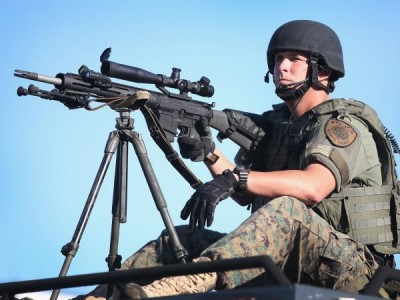Department of Justice: Militarized Police Tactics Caused Ferguson Riots

Police apologists, who have long claimed the violent response by officers to demonstrations in Ferguson was perfectly justified and appropriate, might soon be eating crow.
According to a Department of Justice document obtained by the St. Louis Post-Dispatch, the police effort to handle protests with inappropriate, militaristic tactics not only violated constitutional rights, it effectively antagonized and incited the crowd—creating the very situation police ostensibly sought to prevent.
Essentially, rioting likely wouldn’t have occurred without police provocation.
From the lack of public information from commanders following the killing of Michael Brown to the disproportionate, “highly elevated tactical response” to ensuing protests—if police had responded professionally and responsibly, it’s entirely possible the situation would have remained peaceful.
“Had law enforcement released information on the officer-involved shooting in a timely manner and continued the information flow as it became available, community distrust and media skepticism would most likely have been lessened,” states the summary of the report, which is slated for delivery to top police officials later this week. It follows an assessment of the 16 days immediately following the August 9, 2014 shooting death of the unarmed 18-year-old by officer Darren Wilson. None of the findings seem to justify the heavy-handed police actions during those protests.
Use of police canines for crowd control “exacerbated tensions by unnecessarily inciting fear and anger among amassing crowds” and should no longer be permitted, states the summary.
“(Tear gas) was deployed without proper warning, without sufficient attention paid to egress, and without consideration given to environmental conditions.”
“Vague and arbitrary” orders that confined protesters to sidewalks and kept them constantly moving “violated citizens’ rights to assembly and free speech, as determined by a U.S. federal court injunction,” the report states. That much was readily apparent to Ferguson protesters—police continually herded and shoved the public and members of the media whenever someone briefly strayed into the street.
Further, inordinate use of force and decisions about arrests lacked consistency. According to the document,
“The four core agencies dedicated officer training on operational and tactical skills without appropriate balance of de-escalation and problem-solving training.”
Though the report focuses on general department actions instead of specifically naming individuals, it is nonetheless replete with examples of the bungled handling of the situation in Ferguson:
“The overwatch tactic, in which police snipers took positions on top of tactical vehicles and lowered their rifle sights to monitor the crowd is inappropriate as a crowd control measure” and “exacerbate[d] tensions between protesters and police.”
Despite the need for militaristic, tactical measures in certain cases, an“elevated daytime response was not justified and served to escalate rather than de-escalate the overall situation.”
Further, none of the departments were technologically prepared for “the volume and severity of personal threats” from hacks of information, but officers’ removing their nametags from uniforms in response “defeated an essential level of on-scene accountability that is fundamental to the perception of procedural justice and legitimacy.”
The report suggests that the low number of citizen complaints during the period of the assessment is “misleading” because, in reality, “a lack of confidence in the complaint process likely deterred citizens from filing complaints about police behavior.”
Several telling suggestions are made in the summary:
-Possible color-coding of non-lethal weapons for officer and civilian clarification.
-“Officers wearing defensive and tactical equipment should be should be staged out of sight during peaceful demonstrations.”
-“Armored vehicles should not be visible to protesters except in narrowly defined circumstances, for example when shots are fired and in some active shooter situations.”
Police officials from each of the city, county, and state departments either declined to comment or said they would need to review the entire report before doing so. This will be the third report stemming from the Ferguson fiasco. The first report was the decision not to prosecute Darren Wilson for killing Mike Brown; the second was a rather scathing review of the Ferguson Police Department—the gist of which concluded the overwhelmingly white police force consistently and unjustly targeted black citizens. An analysis of the St. Louis County Police Department is the subject of the fourth report and will be forthcoming in July, according to unnamed sources cited by the Post-Dispatch.
Propagandized, State-slanted media embellishments led the masses to vehemently defend the police response to the Ferguson “riots.” This report serves as an official verification—and perhaps cynical vindication for many—that the indiscriminate, brutal crackdown on protests was as inappropriate, inept, and unconstitutional as it gets.

